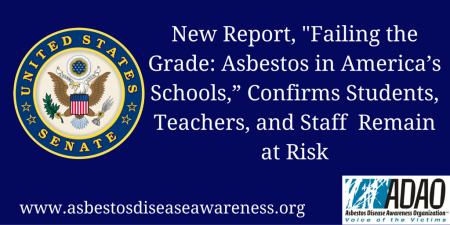Posted on December 7, 2015

- Scope of Asbestos Hazards in Schools
- Awareness and Monitoring of Asbestos Hazards in Schools
- Asbestos Abatement Status
- Asbestos Accreditation, Training and Licensure
- Asbestos Notifications to Parents, Teachers and Staff
- Reporting to the EPA
Today, Senator Ed Markey released the report, “Failing the Grade: Asbestos in America’s Schools” based on an investigation he launched with Senator Barbara Boxer in March 2015. The report, based on responses from 20 states, “reveals that even basic information such as how many schools continue to contain asbestos-containing materials is often either unknown or unreported.”
“We know so little about current asbestos hazards in our schools, and what we do know indicates we have a widespread problem in addressing this toxic threat.” said Senator Markey. “Decades of inaction have put students and teachers at risk of asbestos exposure. We need to enact legislation that arms consumers with information about where asbestos can be found so they can avoid exposure, and create a more systemic and dedicated commitment to removing it from schools.”
Important points of the “Failing the Grade: Asbestos in America’s Schools” report are:
- The scope of asbestos hazards in schools in the United States is likely widespread but remains difficult to ascertain.
- More than two-thirds of state education agencies reported having schools that contain asbestos, most of which is also unabated.
- States do not appear to be systematically monitoring, investigating or addressing asbestos hazards in schools.
- The majority of states responding were unable even to tally complaints and tips of alleged violations.
- States do not report conducting regular inspections of local education agencies to detect asbestos hazards and enforce compliance.
- A majority of responding states were unable to outline a clear inspection or audit schedule for schools, and only three of the responding states indicated that each school district is audited or inspected periodically.
- Of the 3,690 school districts that include schools containing asbestos, only 288 are reported to be subject to periodic inspections.
- States do not report record-keeping activities intended to keep track of asbestos hazard information or remediation activities in schools.
- A majority of states responding were unable to provide data on the frequency of reporting of asbestos-related information about schools to the state or to parents.
- Five states responded that there is no asbestos-related information about schools reported to the Environmental Protection Agency (EPA), or that there are no requirements for the state to communication with the EPA about AHERA.
Asbestos Remains Legal and Lethal in the United States Today
Asbestos was heavily used in homes, workplaces and schools built between the 1940s and the late 1980s. When asbestos fibers are released into the air, during home renovation or other unintended disturbances, exposure can cause cancers such as lung cancer, mesothelioma and other lung diseases. Presently, approximately 15,000 Americans die from preventable asbestos-caused diseases each year.
In 1984, the EPA published the “Asbestos in Buildings National Survey”, which “estimated that asbestos-containing materials (ACM), existed in most of America’s approximately 107,000 primary and secondary schools as well as 733,000 public and commercial buildings.” Furthermore, the EPA survey found that “approximately 34,800 schools were believed to have friable ACM, potentially exposing an estimated 15 million students and 1.4 million school employees.”
Even after the 1984 EPA asbestos survey confirmed the health dangers, use still continued. Between 1984 and 2015, the USA consumed 1,038,481 metric tons of asbestos “to meet manufacturing needs.”
As a result of the survey, two years later, Congress passed the AHERA legislation which requires “local educational agencies to inspect their school buildings for asbestos-containing building material, prepare asbestos management plans and perform asbestos response actions to prevent or reduce asbestos hazards.”
The Human Cost of Inaction
In 2014, ADAO learned about the California Ocean View School District’s struggle to rid itself of this deadly carcinogen. The Orange County Register reported that after receiving results confirming the presence of asbestos in one of their classrooms, the Huntington Beach school district decided to close their Lake View, Oak View and Hope View schools immediately. Unfortunately Lake View is still closed today and will be for the entire 2015-2016 school year. As of the beginning of 2015, the school district has spent $3.5 million on combating the asbestos exposure problem. Unfortunately their total unexpected expenditures are believed to range from $7.7 – $11 million which includes a weekly $50,000 expense alone for busing the children to other schools. It is imperative the we catch and solve these problems early before millions more in lives and dollars are lost through asbestos related diseases.
With nearly 40 Americans dying each day from preventable asbestos related diseases, all 50 states must recognize the importance of AHERA and ensure they are following these federal regulations. The U.S. Senate has passed 11 resolutions and the U.S. Surgeon General has made 4 statements about the hazardous effects of asbestos all within the past 10 years, all indicators that asbestos is an important public health issue.
History is a great teacher to those who listen. Congress must take action to protect public health, consumer safety, and our environment by passing legislation that ends the asbestos man-made disaster.
Linda
